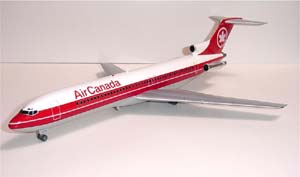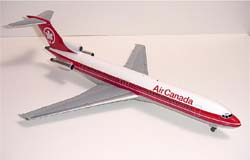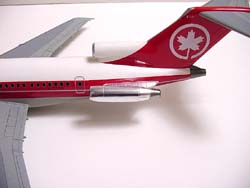Air Canada "The Home Team" Nitto/Doyusha 1/100 727-200 By Andrew Forster |  | †It all started with a good find at a flea market. I found this 1/100th scale Boeing 727-200 bagged kit. Unfortunately it had no instructions or decals. Also missing was the main gear doors.  The 727 has been around since the sixties. This famous Boeing design has been operated by many airlines around the world such as Northwest, Delta, United, British Airways, and Lufthansa to name a few. Unfortunately by todayís standards itís not very efficient so they are quickly being retired for newer designs. The 727 has been around since the sixties. This famous Boeing design has been operated by many airlines around the world such as Northwest, Delta, United, British Airways, and Lufthansa to name a few. Unfortunately by todayís standards itís not very efficient so they are quickly being retired for newer designs.
I decided to build this kit in the Air Canada scheme since I work for an Air Canada connector Airline† The decals came from AHS or better known as Airline Hobby Supply.† They are listed as Decal sheet AHS1016 Air Canada 727-200 1988cs and come with full logos and stripes. Sheet AHS1111 was used for all windows.  The build of this kit was fairly straight forward. I added nose weight and a brass tube for the engine intakes. All the gluing and seam filling was accomplished with Cyanocrylate and accelerator to speed up the build process. The windows were also filled with the Super glue (Cyano) as the windows were actual placed too low on the fuselage. Here is where window decals come into play. I cut the Horizontal stabilizers off the top tail piece. This was so I could glue them in place after the fuselage was painted. The tail piece was glued in place and seam filled in. The wings and Stabs were constructed with super glue as well. I ended up sanding down all fuselage and flying surfaces to get rid of raised panel lines. The wings and stabs were rescribed with an Ofla P-cutter. I ended up using a piece of acrylic on the wing tips for the nav/strobe lights. It was glued in place with cyano then filed sanded and polished. The build of this kit was fairly straight forward. I added nose weight and a brass tube for the engine intakes. All the gluing and seam filling was accomplished with Cyanocrylate and accelerator to speed up the build process. The windows were also filled with the Super glue (Cyano) as the windows were actual placed too low on the fuselage. Here is where window decals come into play. I cut the Horizontal stabilizers off the top tail piece. This was so I could glue them in place after the fuselage was painted. The tail piece was glued in place and seam filled in. The wings and Stabs were constructed with super glue as well. I ended up sanding down all fuselage and flying surfaces to get rid of raised panel lines. The wings and stabs were rescribed with an Ofla P-cutter. I ended up using a piece of acrylic on the wing tips for the nav/strobe lights. It was glued in place with cyano then filed sanded and polished.
 Now for the painting process. I used all lacquer paints. I taped over the nav/strobe wing lights. The fuselage was painted with Tamiya Pure white out of a spray can. The gray for the fuselage was Mr. Color lacquer by Gunze. I ended up masking with Tamiya tape and painting all the stripes with Mr. Color. Which I must say for my first time painting stripes I was rather pleased. The wings got the same treatment of paint including the coroguard center panels which were taped off and painted. For the next treatment on the paint I rubbed the fuselage down with a Micromesh polishing kit. The final painting on the fuselage was to mask off the engines and spray two coats of Alclad 2 Chrome right over the white paint. Put you sunglasses on what bright stuff! Now for the painting process. I used all lacquer paints. I taped over the nav/strobe wing lights. The fuselage was painted with Tamiya Pure white out of a spray can. The gray for the fuselage was Mr. Color lacquer by Gunze. I ended up masking with Tamiya tape and painting all the stripes with Mr. Color. Which I must say for my first time painting stripes I was rather pleased. The wings got the same treatment of paint including the coroguard center panels which were taped off and painted. For the next treatment on the paint I rubbed the fuselage down with a Micromesh polishing kit. The final painting on the fuselage was to mask off the engines and spray two coats of Alclad 2 Chrome right over the white paint. Put you sunglasses on what bright stuff!
†All the decals were applied using Solvaset decal solution. Some may find it a little strong. I prefer to use it on all decals to give the painted on look. I then brushed on two coats of Future with a fine Sable brush (3/4í). Important point was to wait at least 12 hours before recoating. To finish off the wings I applied a gray India ink wash to dirty them up a little. This was then clear coated with lacquer.† The landing gear was painted with enamels and given a dull coat spray.  For final construction I glued the wings and stabs on. The stabs were reinforced with a piece of sheet plastic between halves. Next came the gear. I used 5 minute epoxy to give me time to line them up. Then I used a piece of clear tinted with Tamiya Clear red for a fuselage rotating beacon. For final construction I glued the wings and stabs on. The stabs were reinforced with a piece of sheet plastic between halves. Next came the gear. I used 5 minute epoxy to give me time to line them up. Then I used a piece of clear tinted with Tamiya Clear red for a fuselage rotating beacon.
Overall for a dated kit it was relatively a simple build. I donít know if this kit is readily available anymore. It was issued in the seventies I think. You may find one like I did at flea market or model show in your area. Over all the tail doesnít look very accurate comparing it to pictures. But itís not a bad rendition of this famous airliner. | 








|
